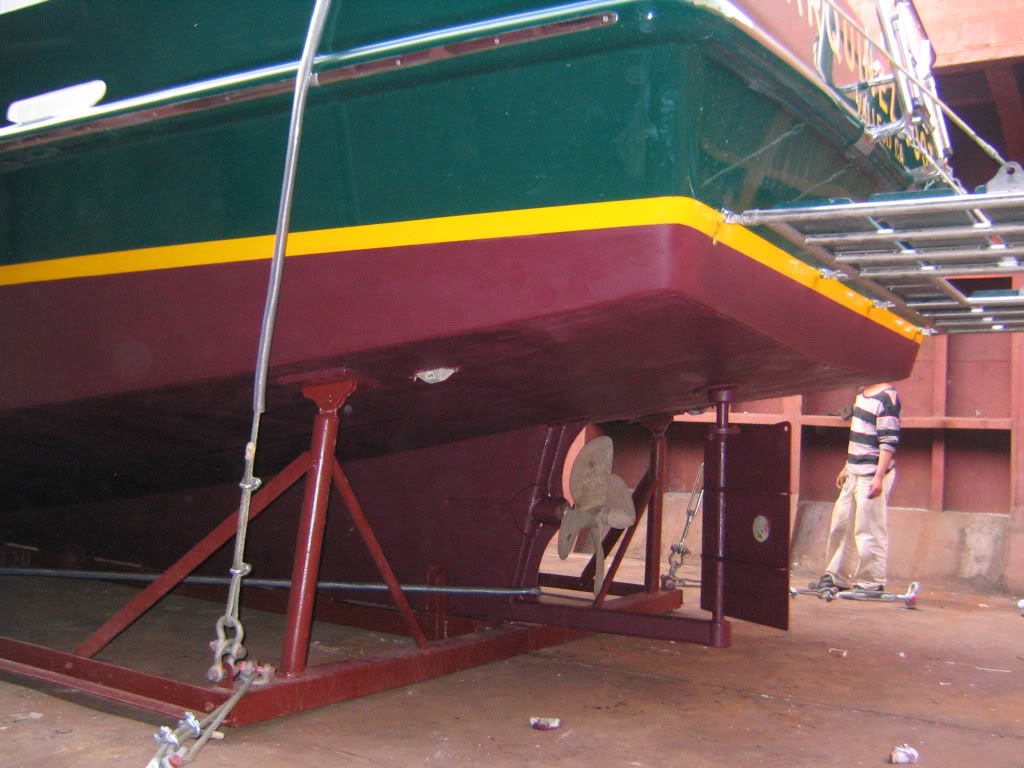Tony B wrote:
*
Say for instance, I have 2 identical 40' trawlers except one has a single 120HP engine and the other has twin 120 HP engines. Now, say that I burn 2 gal/hr on the single screw at 6 knots. That gives me roughly 3 NMPG in dead calm and no curent. If I wanted to go the same 6 NM's (distance) with the twins how much fuel will I consume and at what approx. speed? Would I be actually traveling faster with less fuel burn per engine or is it not possible to get the same overall 3NMPG?*
I don't have specific numbers because to get those you need an accurate fuel flow measurement system and you need it on two identical boats, one single and one twin.* So the best I can do is offer a rough-ish comparison.
With our twin-engine GB36, 1650 rpm on both engines gets us about 8 knots and the boat burns about 5 gph (total) to do that.* To get 8 knots with the same boat with one engine, the engine needs to be run at about 1800-1900 rpm.* At that rpm the engine will burn about 3-4 gph.* A big variable here will be prop configuration, of course.
So you need to pick your poison.* Going the same distance at the same speed, the twin will burn more than the single, but certainly not double the amount.* Probably more like 2/3 the amount but that's a guesstimate.* If you want to burn the same amount of fuel in each boat over the same distance the engines in the twin will have to be run slower than the engine in the single.* How much slower is what requires some accurate measurements.* But I would hazard that if we're talking about a 5 to 8 knot speed range, the engines in the twin might have to be run too slow for their own good.
Frankly, I think debating a single vs twin on the basis of fuel burn (assuming the same kind of boat and engines) is perhaps debating the wrong thing.* In the typical, slow cruiser with low-powered engines like the FL120, the difference in fuel burn between the single and twin is not going to be so different as to negate the other advantages and disadvantages of either configuration.* When we decided to acquire an older GB we didn't care if it was a single or a twin.* The boat that best met our needs and budget happened to be a twin, and having run it for 13 years now neither one of us would want to go back to a single, which is what we chartered before buying our own boat.
But our preference for a twin over a single has nothing to do with fuel burn. The factors of our preference are redundancy, maneuverability, and the fact I like running multiple engines

* If we preferred a single-engine boat, the main factors would not be fuel savings but things like half the service and maintenance cost, ease of engine servicing in an uncrowded engine room, simpler systems, less noise, a more protected prop, and so on.* The fuel savings would be a nice bonus, of course, but they would not be the reason we opted for a single engine boat.
Not sure how you come up with an annual fuel cost of $15k-$20k.* Most boat owners run their boats less than 100 hours a year.* But I believe 100 hours a year is considered the average use of a recreational boat for most people, full-time cruisers excepted.* Assuming a fuel consumption of 5 gph (twin-engine boat) and a fuel price of $5/gal, 100 hours a year is $2,500 in fuel costs.* If one cruises 500 hours a years, given the same fuel burn and gallon price, that's $12,500 in fuel for the year.
I have no clue what kind of annual hours are typically racked up on the rivers, lakes, and waterways that comprise the Loop nor do I know how much of the year you intend to be actually runninng the boat.* But if you're assuming you'll be spending $15k to $25k in fuel each year, I see a twin-engine boat in your future
 -- Edited by Marin on Wednesday 24th of August 2011 09:10:06 AM
-- Edited by Marin on Wednesday 24th of August 2011 09:10:06 AM

